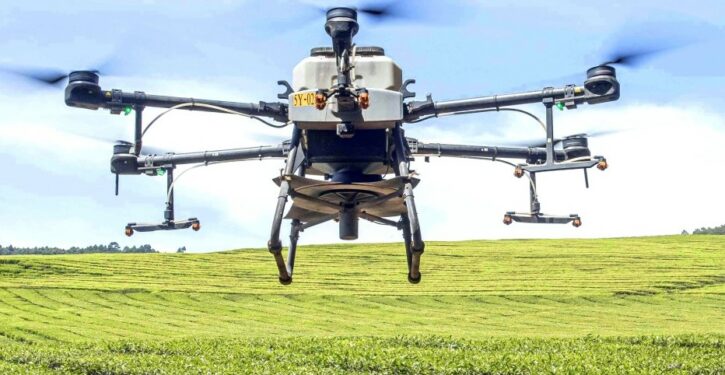
Early one recent morning in Vidalia, Georgia, third-generation farmer Greg Morgan launched an AG-230 drone carrying eight gallons of fungicide over a field of sweet onions. The chemical, which is essential to crop survival in this humid state, would typically be dragged and dripped from a 500-gallon tank behind Morgan’s 10,000-pound tractor. Now it fell in a fine mist from the spray jets of an 80-pound drone scudding 10 feet above his cash crop.
Vidalia Onions are a $150 million local industry….Morgan has joined the vanguard of farmers who are turning away from tractors and toward drones…Farmers have been using drones over the past 20 years mainly for aerial imaging — scanning farms from the sky with cameras to map where crops are thriving and failing. Now drones are being designed for hands-on crop management: enabled to spray herbicides, insecticides and foliar fertilizers with precision, and even to distribute seeds in planting season.
A “featherweight flying tractor” — that’s how Arthur Erickson, chief executive of manufacturer Hylio Inc., described the company’s agricultural drones. The Houston-based startup has seen demand for its drones soar over the past three years; roughly 700 of Hylio’s drones are now at work treating 700,000 acres of cropland annually — including Morgan’s farm….Drones are poised to significantly disrupt the tractor industry, and unlike many other high-tech agricultural trends, this one is actually good for small and midsized farmers, and a big win for the planet, to boot.
In the eight months since Morgan made his $40,000 investment — a whole lot cheaper than the roughly $700,000 it would have cost to replace his old ground rig — it has cut his fuel costs and already reduced his agrochemical usage by about 15%. The drone has also enabled him to work his fields after heavy rains — when the ground is often too sodden for heavy equipment — and has spared his crop from the routine damage caused by tractors. It has also saved his soil from the compaction, bogging and erosion caused by farm machinery.
A Bloomberg News reporter first witnessed a farm drone (agrodrone”) at work in 2022 on a large soy and corn farm in Iowa. The farm owner launched an MG-1P Rantizo drone made in China that was 9 feet wide with 8 propellers. For an entire morning, the farmer guided his drone to spray an organic pesticide at a rate of 2 gallons per acre and 14 acres per hour. That afternoon, it switched tasks and dropped rye seeds across soy fields at a rate of 25 pounds per acre. As Bloomberg News notes, “These aerial acrobats use less than a tenth of the energy of ground tractors — and they don’t squash the crops, rut the earth or even touch the soil.” Even more than the large soy and corn farm, Morgan’s small “onion farm offered even more convincing evidence….Morgan struggles to stay profitable on his 300 acres. The drone purchase for him was not a whiz-bang new toy, but a survival tool that allowed him to minimize his expenses.”
Drones are rapidly getting more advanced:
As the hardware of agrodrones becomes increasingly sophisticated — with smaller, longer-lasting batteries and lighter, stronger carbon-fiber frames — so does the software, which is being developed by startups such as Canada’s Precision AI. The AI software will enable drones to use computer vision to identify exactly where and how much chemical is needed, plant by plant rather than blanketing an entire field with the same treatment.
Drones won’t completely replace tractors anytime soon. Their payload is limited to about 20 gallons, not nearly enough to handle the hundreds-of-pounds-per-acre fertilizer applications required between harvests. But they’re certainly capable of displacing the expensive, wasteful crop-dusting of herbicides and fungicides still performed by airplanes and helicopters across millions of acres.
Whereas crop-dusting spreads chemicals that bleed beyond the edges of the fields, drones deliver the chemicals in fine mists directly into the crop without overspill. The nimble flyers can work around obstacles like powerlines and trees, drastically increasing the efficiency of chemical applications.
In other good news, researchers have developed a banana with slight genetic modifications to keep the current, tasty type of banana most people eat from being wiped out. Fifty years ago, bananas were tastier than they are today, but the type of banana most people ate back then was entirely wiped out by a blight. A blight threatens to wipe out the current variety of banana most people eat, resulting in people having to eat varieties of banana most people consider less tasty or which are much smaller.
Drones are not the only innovation being used to make work cheaper and easier. Doctors recently used a surgical robot to carry out incredibly complicated spinal surgery. Doctors also recently did the first robotic liver transplant in America. Korean restaurants are increasingly using robot waiters. A U.S. restaurant chain is using robots to speed up service.
In other news, a plant virus may save crops from root-eating pests. A virus is being used to cure deafness in new gene therapy. A mutant tomato could save harvests around the world. Farmers have found they can increase crop yields by using electrical stimulation on their crops.
Scientists are planning to use proteins found in ferns as a potent weapon against pests, reducing the need for environmentally-harmful pesticides.
Scientists recently engineered bionic silkworms that spin fibers six times stronger than Kevlar.



